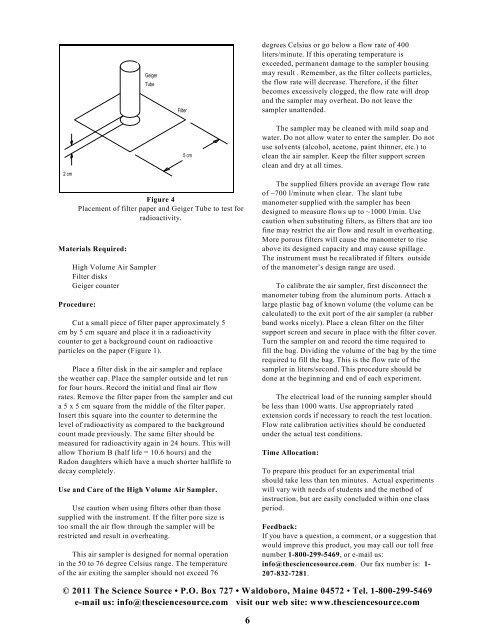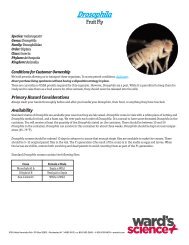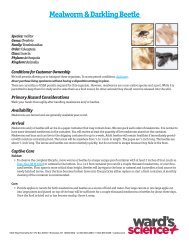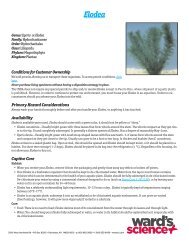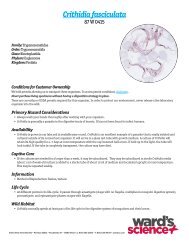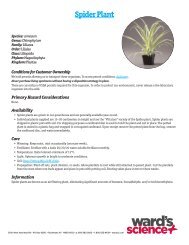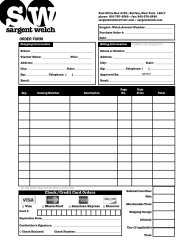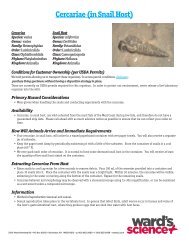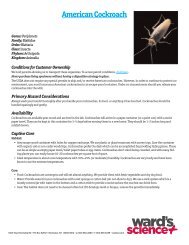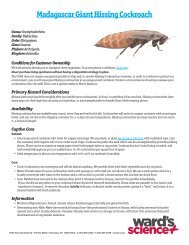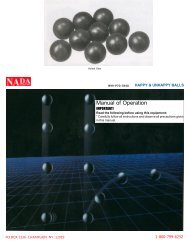High Volume Air Sampler Operating Instructions - Sargent Welch
High Volume Air Sampler Operating Instructions - Sargent Welch
High Volume Air Sampler Operating Instructions - Sargent Welch
You also want an ePaper? Increase the reach of your titles
YUMPU automatically turns print PDFs into web optimized ePapers that Google loves.
degrees Celsius or go below a flow rate of 400<br />
liters/minute. If this operating temperature is<br />
exceeded, permanent damage to the sampler housing<br />
may result . Remember, as the filter collects particles,<br />
the flow rate will decrease. Therefore, if the filter<br />
becomes excessively clogged, the flow rate will drop<br />
and the sampler may overheat. Do not leave the<br />
sampler unattended.<br />
The sampler may be cleaned with mild soap and<br />
water. Do not allow water to enter the sampler. Do not<br />
use solvents (alcohol, acetone, paint thinner, etc.) to<br />
clean the air sampler. Keep the filter support screen<br />
clean and dry at all times.<br />
Figure 4<br />
Placement of filter paper and Geiger Tube to test for<br />
radioactivity.<br />
Materials Required:<br />
<strong>High</strong> <strong>Volume</strong> <strong>Air</strong> <strong>Sampler</strong><br />
Filter disks<br />
Geiger counter<br />
Procedure:<br />
Cut a small piece of filter paper approximately 5<br />
cm by 5 cm square and place it in a radioactivity<br />
counter to get a background count on radioactive<br />
particles on the paper (Figure 1).<br />
Place a filter disk in the air sampler and replace<br />
the weather cap. Place the sampler outside and let run<br />
for four hours. Record the initial and final air flow<br />
rates. Remove the filter paper from the sampler and cut<br />
a 5 x 5 cm square from the middle of the filter paper.<br />
Insert this square into the counter to determine the<br />
level of radioactivity as compared to the background<br />
count made previously. The same filter should be<br />
measured for radioactivity again in 24 hours. This will<br />
allow Thorium B (half life = 10.6 hours) and the<br />
Radon daughters which have a much shorter halflife to<br />
decay completely.<br />
Use and Care of the <strong>High</strong> <strong>Volume</strong> <strong>Air</strong> <strong>Sampler</strong>.<br />
Use caution when using filters other than those<br />
supplied with the instrument. If the filter pore size is<br />
too small the air flow through the sampler will be<br />
restricted and result in overheating.<br />
This air sampler is designed for normal operation<br />
in the 50 to 76 degree Celsius range. The temperature<br />
of the air exiting the sampler should not exceed 76<br />
The supplied filters provide an average flow rate<br />
of ~700 l/minute when clear. The slant tube<br />
manometer supplied with the sampler has been<br />
designed to measure flows up to ~1000 l/min. Use<br />
caution when substituting filters, as filters that are too<br />
fine may restrict the air flow and result in overheating.<br />
More porous filters will cause the manometer to rise<br />
above its designed capacity and may cause spillage.<br />
The instrument must be recalibrated if filters outside<br />
of the manometer’s design range are used.<br />
To calibrate the air sampler, first disconnect the<br />
manometer tubing from the aluminum ports. Attach a<br />
large plastic bag of known volume (the volume can be<br />
calculated) to the exit port of the air sampler (a rubber<br />
band works nicely). Place a clean filter on the filter<br />
support screen and secure in place with the filter cover.<br />
Turn the sampler on and record the time required to<br />
fill the bag. Dividing the volume of the bag by the time<br />
required to fill the bag. This is the flow rate of the<br />
sampler in liters/second. This procedure should be<br />
done at the beginning and end of each experiment.<br />
The electrical load of the running sampler should<br />
be less than 1000 watts. Use appropriately rated<br />
extension cords if necessary to reach the test location.<br />
Flow rate calibration activities should be conducted<br />
under the actual test conditions.<br />
Time Allocation:<br />
To prepare this product for an experimental trial<br />
should take less than ten minutes. Actual experiments<br />
will vary with needs of students and the method of<br />
instruction, but are easily concluded within one class<br />
period.<br />
Feedback:<br />
If you have a question, a comment, or a suggestion that<br />
would improve this product, you may call our toll free<br />
number 1-800-299-5469, or e-mail us:<br />
info@thesciencesource.com. Our fax number is: 1-<br />
207-832-7281.<br />
© 2011 The Science Source • P.O. Box 727 • Waldoboro, Maine 04572 • Tel. 1-800-299-5469<br />
e-mail us: info@thesciencesource.com visit our web site: www.thesciencesource.com<br />
6


